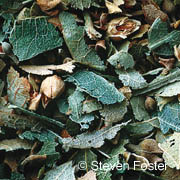Linden
Common lime; European lime; Lime tree; Tilia cordata; Tilia platyphyllos
Linden is an herb that comes from various species of Tilia, or lime tree. It has been used in European folk medicine for centuries to treat a wide range of health problems. Flowers from 2 linden species (Tilia cordata and Tilia platyphyllos) were historically used to soothe nerves and treat health problems associated with anxiety. These flowers were steeped as a tea to relieve anxiety related to indigestion, irregular heartbeat, and vomiting. Today, linden is used in many cough and cold remedies. Active ingredients in linden help promote sweating, which may help treat people with fevers. However, scientific evidence on linden's effectiveness is lacking. Lime trees are also valued for their wood and charcoal, and for the honey made from their flowers.
Plant Description
The Tilia species grows in temperate climates in the north. They are deciduous trees (losing their leaves in winter) that can grow to a height of 90 feet and may live up to 1,000 years. Herbal linden flower formulas typically call for either Tilia cordata, the small leafed European linden also known as the winter linden, or Tilia platyphyllos, the large leafed, early blooming summer linden. Both species are often planted along city streets. Depending on the species, their fragrance ranges from strong and sweet to quite rich. The dried flowers are mildly sweet and sticky, and the fruit is somewhat sweet and slimy. Linden tea has a pleasing taste, due in part to the aromatic volatile oil found in the flowers.
Parts Used
Linden flowers, leaves, wood, and charcoal (obtained from the wood) are the parts used for medicinal purposes. Active ingredients in the linden flowers include flavonoids (which act as antioxidants), volatile oil, and mucilage components (which are soothing and reduce inflammation). The plant also contains tannins that can act as an astringent.
Medicinal Uses and Indications
Tilia has been studied in only a few test tube and animal trials. It appears to have antispasmodic (reducing muscle contractions), astringent (drying), diuretic, and sedative properties. Note that different parts of Tilia species are used in treating specific conditions and symptoms.
Colds and Coughs
Tilia cordata/platyphyllos flowers are sometimes suggested to treat colds, cough, fever, infections, inflammation, high blood pressure, headache (particularly migraine); as a diuretic (increases urine production), antispasmodic (reduces smooth muscle spasm along the digestive tract), and sedative.
Other
- Tilia cordata/platyphyllos wood is used for liver and gallbladder disorders and cellulitis (inflammation of the skin and surrounding soft tissue).
- Tilia cordata/platyphyllos charcoal has been used orally to treat intestinal disorders and used topically to treat swelling (edema) or infection (such as cellulitis or ulcers) of the lower leg.
Available Forms
Linden is available as:
- Dried flower preparations, including teas and capsules
- Fluid extract
- Tincture
How to Take It
Pediatric
There are no scientific studies looking at the use of linden to treat children, so you should not give linden to a child under 18 without your health care provider's supervision.
Adult
Speak to a knowledgeable provider to find the right dose for you.
Precautions
The use of herbs is a time-honored approach to strengthening the body and treating disease. Herbs, however, contain components that can trigger side effects and interact with other herbs, supplements, or medications. For these reasons, you should take herbs with care, preferably under the supervision of a health care provider knowledgeable in the field of botanical medicine.
Linden is considered safe at the recommended dosage. There have been rare reports of hives or other allergic skin reactions (called contact dermatitis) from touching the lime tree.
Frequent use of linden has been linked with heart damage. DO NOT use without medical supervision if you have heart disease.
Women who are pregnant or breastfeeding should ask their providers before taking linden.
Possible Interactions
There are no known scientific reports of interactions between linden and conventional medications. However, it is possible that linden may interact with the following:
Diuretics (water pills): Linden is thought to have diuretic properties, meaning it helps the body get rid of fluid by increasing urine output. If you take other diuretics, linden might increase their effects and raise your risk of dehydration.
Lithium: Because linden may act as a diuretic, it could increase the concentration of lithium in your blood. If you take lithium, talk to your doctor before taking linden.
Supporting Research
Aguirre-Hernandez E, Martinez AL, Gonzalez-Trujano ME, Moreno J, Vibrans H, Soto-Hernandez M. Pharmacological evaluation of the anxiolytic and sedative effects of Tilia americana L. var. mexicana in mice. J Ethnopharmacol. 2007;109(1):140-145.
Bianca MI. Linden flower (Tillia Spp.) as potential vehicle of Clostridium botulinum spores in the transmission of infant botulism. Rev Argent Microbiol. 2009;41(4):232-6.
Blumenthal M, Busse WR, Goldberg A, et al., ed. The Complete German Commission E Monographs. Therapeutic Guide to Herbal Medicines. Boston, MA: Integrative Medicine Communications; 1998:163, 342, 343.
Blumenthal M, Goldberg A, Brinckmann J. Herbal Medicine: Expanded Commission E Monographs. Newton, MA: Integrative Medicine Communications; 2000:240-243.
Coleta M, Campos MG, Cotrin MD, Proenca de Cunha A. Comparative evaluation of Melissa officinalis L., Tilia eruopaea L., Passiflora edulis Sims. and Hypericum perforatum L. in the elevated plus maze anxiety test. Pharmacopsychiatry. 2001;34 Suppl 1:S20-S21.
Gruenwald J, Brendler T, Christof J. PDR for Herbal Medicines. 4th ed. Montvale, NJ: Thomson Healthcare; 2007:532-534.
Herrera-Ruiz M, Román-Ramos R, Zamilpa A, Tortoriello J, Jiménez-Ferrer JE. Flavonoids from Tilia americana with anxiolytic activity in plus-maze test. J Ethnopharmacol. 2008 Jul 23;118(2):312-7. Epub 2008 Apr 24.
Martínez AL, González-Trujano ME, Aguirre-Hernández E, Moreno J, Soto-Hernández M, López-Muñoz FJ. Antinociceptive activity of Tilia americana var. mexicana inflorescences and quercetin in the formalin test and in an arthritic pain model in rats. Neuropharmacology. 2009 Feb;56(2):564-571. Epub 2008 Nov 5.
Matsuda H, Ninomiya K, Shimoda H, Yoshikawa M. Hepatoprotective principles from the flowers of Tilia argentea (linden): structure requirements of tiliroside and mechanisms of action. Bioorg Med Chem. 2002;10(30:707-712.
Mur P, Feo Brito F, Lombardero M, et al. Allergy to linden pollen (Tilia cordata). Allergy. 2001;56(5):457-458.
Pérez-Ortega G, Guevara-Fefer P, Chávez M, Herrera J, Martínez A, Martínez AL, González-Trujano ME. Sedative and anxiolytic efficacy of Tilia americana var. mexicana inflorescences used traditionally by communities of State of Michoacan, Mexico. J Ethnopharmacol. 2008 Mar 28;116(3):461-8.
Picardo M, Rovina R, Cristaudo A, Cannistraci C, Santucci R. Contact urticaria from Tilia (lime). Contact Dermatitis. 1988;19(1):72-73.
Rodriguez-Fragoso L, Reyes-Esparza J, Burchiel SW, Herrera-Ruiz D, Torres E. Risks and benefits of commonly used herbal medicines in Mexico. Toxicol Appl Pharmacol. 2008 Feb 15;227(1):125-35. Review.
Schulz V, Hansel R, Tyler V. Rational Phytotherapy: A Physician's Guide to Herbal Medicine. 4th ed. Berlin: Springer; 2001:172-173.
Toker G, Asian M, Yesilada E, Memisoglu M, Ito S. Comparative evaluation of the flavonoid content in officinal Tillae flos and Turkish lime species for quality assessment. J Pharm Biomed Anal. 2001;26(1):111-112.
Yayalaci Y, Celik I, Bati B. Hepatoprotective and antioxidant activity on linden (Tilia platyphyllos L.) infusion against ehtanol-induced oxidative stress in rats. J Memb Biol. 2014;247(2):181-8.
Yildirim A, Mavi A, Oktay M, Kara AA, Algur OF, Bilaloglu V. Comparison of antioxidant and antimicrobial activities of tilia (Tilia argentea Desf ex DC), sage (Salvia triloba l.), and black tea (Camellia sinensis) extracts. J Agric Food Chem. 2000;48(10):5030-5034.
Review Date: 1/2/2015
Reviewed By: Steven D. Ehrlich, NMD, Solutions Acupuncture, a private practice specializing in complementary and alternative medicine, Phoenix, AZ. Review provided by VeriMed Healthcare Network.


